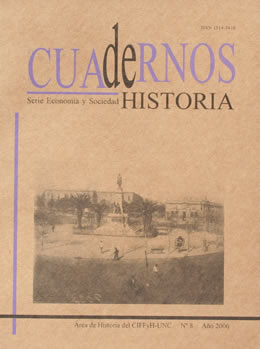The image of Latin America as perceived by Southern Cone diplomats
DOI:
https://doi.org/10.53872/2422.7544.n8.9929Keywords:
Latin America, Southern Cone, nationalisms, diplomatic discourse, imagesAbstract
During the second half of 19th century and the beggining of the 20th century a set of ideas which would reach unpredictable repercussions started to acquire importance in Latin America. We refer to nationalisms. They spread over Latin American countries in relation with different variables such as political and social changes or international situation, which gave many opportunities to express hostility against the foreign or different.
The mentors of nationalisms were engaged in the construction of a nation. For that purpose it was necessary, among other things, to make clear that even if they all were Latin Americans they didn’t share the same characteristics.
With regard to that issue, this article proposes to analyze a representative sample of diplomatic writings which were produced in the Southern Cone. We consider them as a modality of political discourse as well as an efficient instrument of the construction of a particular image of the other.
Although these writings constituted the expression of a group of public officials who addressed their message to a limited addressee, such as the chancelleries of their countries, who enunciated these discourses were also journalists, men of letters or intellectuals who spread their ideas to wider social sectors. In that way, they facilitated the appropriation and permanence of these discourses in other social sectors of national societies.
References
Arguedas, Alcides, 1909, Pueblo Enfermo. Barcelona, Casa Ed. de la Viuda de L. Tasso.
Barros Van Buren, Mario, 1966, La Misión Eastman en el Ecuador. Quito, Casa de la Cultura Ecuatoriana.
Becu, Carlos, 1915, El “ABC” y su concepto jurídico y político. Buenos Aires, Librería La Facultad.
Bueno, Clodoaldo, 1994, As noções de prestígio e soberania na política externa de Rio Branco (1902-1912). En Cervo, Amado e DöPCKE Wolfgang (org.), 1994, Relações Internacionais dos Países Americanos. Vertentes da História. Brasília, Linha Gráfica Editora, 1994, p. 47.
Bunge, Carlos O., 1905, Nuestra América. Buenos Aires, Valerio Abeledo Editores.
Cervo, Amado Luis: O Parlamento Brasileiro e as Relações Exteriores (1826- 1889). Brasília, Editora Universidade de Brasília, 1981, p. 130.
Cunha, Euclides da, 1967, Á margem da história. São Paulo, Lello Brasileira.
Halperin Donghi, Tulio, 1992, Una Nación para el desierto argentino. Buenos Aires, CEAL.
Hardman, Francisco Foot, 1998, Trem Fantasma: A modernidade na selva. São Paulo, Companhia das Letras.
Hobsbawm, Eric, 1991, Naciones y Nacionalismos desde 1780. Barcelona, Crítica.
Monzo, Julio, 1915, El Pacto Pacifista del ABC. Buenos Aires, Imprenta de José Tragant.
Sarmiento, Domingo, 1963, Facundo o Civilización y Barbarie. Buenos Aires, Sopena Argentina. (Edición original, 1845).
Veron, Eliseo, 1987, La Palabra Adversativa. Observaciones sobre la enunciación política. En Veron, E. et all., 1987, El Discurso Político. Lenguajes y acontecimientos. Buenos Aires, Hachette.
Zumeta, César, 1979, El continente Enfermo. México, Universidad Nacional Autónoma, 1979. (Primera edición, 1899)
Downloads
Published
Issue
Section
License
Copyright (c) 2014 Cuadernos de historia. Serie Economía y Sociedad

This work is licensed under a Creative Commons Attribution 4.0 International License.
Authors publishing in this journal accept the following terms:
a. The author maintains their copyrights and grants this journal the publication of the first original version of their work that is subject to the Creative Commons Attribution License 4.0. This license agreement allows:
Sharing — copy and redistribution of the published material by any means and formats
Reusing — remix, change, and creation of new material from the published work for any purpose, including commercial use.
b. Authors may enter other non-exclusive license agreements of distribution of the version of the published work (i.e. uploading the material on an institutional virtual archive or republishing it on a monographic volume) as long as they attribute the publication of the original version to this journal.
c. It is allowed and recommended that authors publicize their work on the Internet (i.e. on institutional virtual archives or on their personal or professional websites) after their work has been published in this journal.




